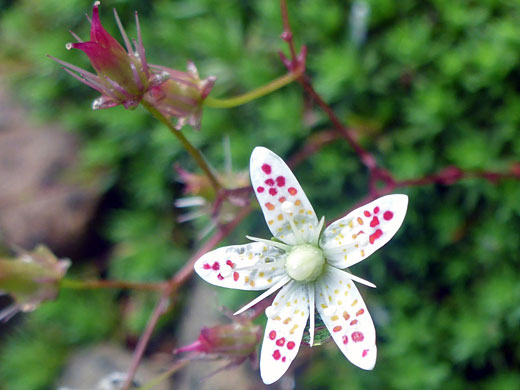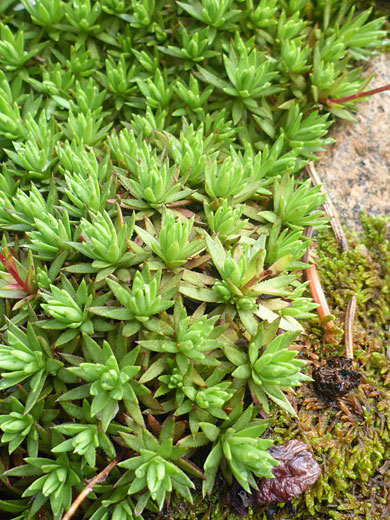Saxifraga Bronchialis, Yellowdot Saxifrage
Plants > Wildflowers > Saxifragaceae > Saxifraga Bronchialis

Saxifraga bronchialis (yellowdot saxifrage) along the Raccoon Trail in Golden Gate Canyon State Park, Colorado
Common names:
Yellowdot saxifrage, spotted saxifrage, prickly saxifrage
Family:
Scientific name:
Saxifraga bronchialis
Synonym:
Saxifraga austromontana
Main flower color:
Range:
From the Pacific Northwest to New Mexico
Height:
Between 2 and 6 inches
Habitat:
Dry, open, rocky locations; montane to alpine; up to 14,500 feet
Leaves:
Linear to lanceolate, up to 0.6 inches long, with coarse edge hairs and a spine at the tip
Season:
June to August
The evergreen, leathery, hairy-edged leaves of saxifraga bronchialis form neat, compact, basal rosettes, growing close together to create large colonies. The reddish green stems have a few well-spaced leaves, attain heights of around 6 inches and bear flat-topped clusters (2 to 10 heads) of dainty white flowers. Stems are covered by short glandular hairs.
Flowers are composed of (usually) five pointed, green, ovate to triangular sepals and the same number of petals, which are flecked by quite large dots, typically colored green-yellow at the base, becoming orange, red and purple towards the tip. White stamens radiate outwards between the petals, and the flower is centered on an upwards-projecting ovary.
There are two subspecies of saxifraga bronchialis, sometimes considered as separate species. Ssp austromontana, by far the most widespread, has petals which are not clawed (narrow at the base), and do have the yellow to purple dot pattern, while the petals of ssp funstonii, found in Canada and Alaska, are clawed, and all the dots are yellow.
Flowers are composed of (usually) five pointed, green, ovate to triangular sepals and the same number of petals, which are flecked by quite large dots, typically colored green-yellow at the base, becoming orange, red and purple towards the tip. White stamens radiate outwards between the petals, and the flower is centered on an upwards-projecting ovary.
There are two subspecies of saxifraga bronchialis, sometimes considered as separate species. Ssp austromontana, by far the most widespread, has petals which are not clawed (narrow at the base), and do have the yellow to purple dot pattern, while the petals of ssp funstonii, found in Canada and Alaska, are clawed, and all the dots are yellow.
All Contents © Copyright The American Southwest | Comments and Questions | Contribute | Site Map






